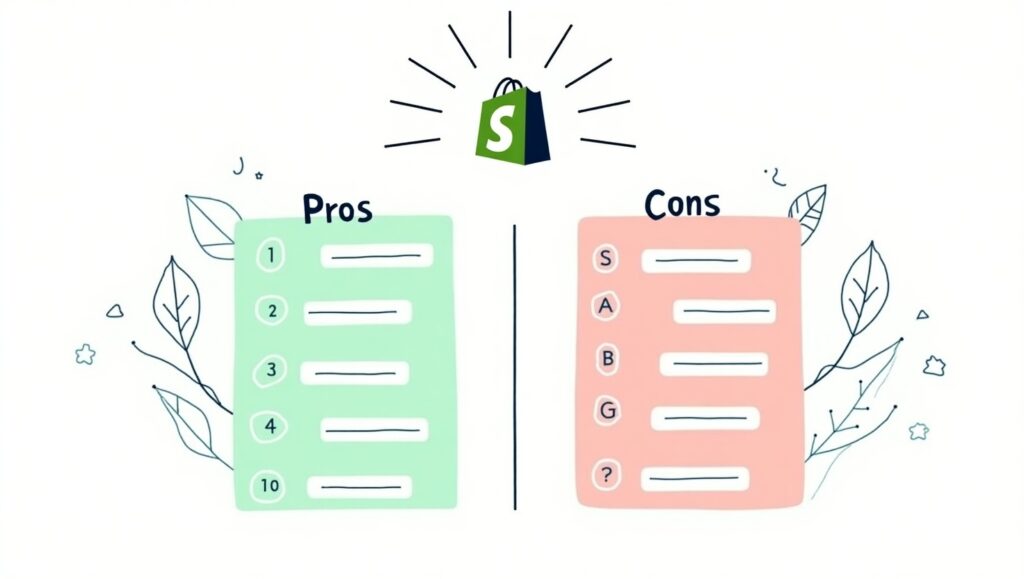
What Is Shopify and Why Is It So Popular?
Shopify stands among the world’s top e-commerce platforms because its system enables individuals and organizations to create online shops effortlessly, even if they have limited technical skills. Shopify began operating in 2006 and has since grown quickly to provide its services to millions of online stores worldwide.
Businesses can effortlessly grow their operations because of the platform’s simple design and reliable hosting, combined with numerous available apps. Shopify delivers flexible e-commerce solutions suitable for launching entrepreneurs opening their first business and large organizations seeking robust online store platforms.
The platform enables merchants to distribute their products across Facebook, Instagram, Amazon, and numerous other marketplaces through a simple setup process. The multichannel capability of Shopify attracts businesses because it enables them to expand their market reach and achieve better market penetration.

Is Shopify Worth It? Discover the Truth Behind the Hype
Shopify Pricing Plans Explained
Shopify presents different pricing plans that adapt to the development needs of businesses at each stage of expansion and respond to their specific size requirements. The plans include:
- Basic Shopify: Startups and new businesses can find the Basic Shopify plan at $39/month, ideal for initial market exploration.
- Shopify: Growing businesses can access advanced features through the $105/month Shopify plan.
- Advanced Shopify: The $399 monthly advanced Shopify plan targets organizations requiring enhanced analytics tools to expand their operations.

All pricing tiers include fundamental e-commerce tools like website builders, payment handling features, SSL security protection, and the Shopify App Store. Higher plan upgrades provide businesses lower transaction fees and better shipping discounts, along with advanced analytics that deliver deeper business insights.
New users can explore Shopify’s features through a 14-day free trial before making a payment decision for its services.
What You Get for Your Money
The Basic plan delivers an extensive array of tools that exceeds typical expectations.
- Responsive mobile themes that present your store beautifully across every device.
- Your catalog expansion remains unrestricted with limitless product listing capabilities.
- Round-the-clock customer support is available to assist you through any technical or operational difficulties.
- Access an integrated blogging platform to enhance your SEO and content marketing initiatives.
- You can sell via different platforms outside your website which including social media and marketplaces.
Businesses that expand rapidly benefit from Shopify’s scalable solutions, which enable them to elevate their plans and integrate additional apps to handle changing needs. The platform’s adaptability guarantees that your business won’t surpass its capabilities too soon.
Who Shopify Is Ideal For
A range of merchants find Shopify attractive because of its user-friendly interface combined with powerful capabilities.
- New e-commerce merchants need a user-friendly drag-and-drop website builder that requires no programming.
- Dropshipping merchants find great advantages through seamless app integrations with Oberlo and DSers.
- Physical stores can use Shopify’s POS system to merge their online and offline sales operations.
- Merchants who sell digital products through download methods or subscription and membership services use Shopify.
Shopify stands out as one of the leading e-commerce platforms for entrepreneurs in 2025 because of its appeal to a diverse range of merchants.
Real User Reviews and Case Studies
Numerous merchants reported improved sales performance and operational efficiency after they implemented Shopify for their businesses. The 2024 annual report from Shopify reveals that merchants on their platform created over $300 billion in worldwide economic activity, indicating significant influence.
Gymshark, Allbirds, and Kylie Cosmetics turned their startups into globally known businesses through Shopify, which proves that Shopify helps brands grow at every phase.
Shopify vs Competitors
Let’s compare Shopify with its e-commerce platform competitors using this quick evaluation:
| Feature | Shopify | Wix | WooCommerce | BigCommerce |
| Ease of Use | 9/10 | 8/10 | 6/10 | 7/10 |
| App Ecosystem | 9/10 | 7/10 | 8/10 | 7/10 |
| Scalability | 10/10 | 6/10 | 8/10 | 9/10 |
| Support | 24/7 | Business Hrs | Community | 24/7 |
This analysis reveals that Shopify stands out in scalability and support, which positions it as an ideal platform for businesses that aim to expand over time.
The Pros and Cons of Shopify You Need to Know Before Starting
Major Pros of Shopify
Online sellers benefit from Shopify through multiple advantages such as:
- The intuitive drag-and-drop interface enables users to navigate effortlessly without needing technical skills.
- The platform implements strong security measures, including SSL certificates and PCI compliance, to protect customer data.
- Through the vast app ecosystem of Shopify, users can find thousands of plugins which help improve marketing efforts and SEO performance and also enable inventory management.
- The platform scales effectively to support business expansion from small startups to big corporations.
- Businesses can connect with clients through their Facebook and Instagram profiles while also selling on Amazon, eBay, and other platforms.

Significant Cons of Shopify
Despite its strengths, Shopify does have drawbacks:
- The inclusion of paid apps and premium themes can rapidly increase monthly expenses on Shopify.
- Using another payment gateway with Shopify results in transaction fees.
- Customizing Shopify design requires coding skills or a developer unless you want to work within limited design options.
- Users must pay extra for third-party apps to access advanced features, which raises total costs.
Is Shopify Plus Worth It? Uncover the Powerful Features That Justify the Cost

What Is Shopify Plus?
High-volume merchants and large businesses receive tailored services from Shopify through its enterprise solution, Shopify Plus. The Shopify Plus plan requires a monthly payment of $2,000 for accessing advanced customization features and automation tools, and offers personalized support that goes beyond regular plan options.
Shopify Plus Features
Shopify Plus provides a suite of advanced tools that includes:
- A specialized account manager will provide guidance for your business expansion.
- Fully customizable checkout experiences to increase conversions.
- Business processes achieve optimal performance through advanced automation with Shopify Flow.
- Shopify Plus provides access to unique APIs that allow for more profound system integrations and tailored application development.
- Wholesale channel capabilities for B2B sales.
- A platform for planning flash sales and marketing initiatives alongside product launches.
Pros and Cons of Shopify Plus
Pros:
- This system effectively manages both high traffic loads and extensive transaction numbers.
- Provides white-glove onboarding and continuous priority support.
- The platform enables personalized integrations alongside specific scripting solutions to address intricate requirements.
Cons:
- The high monthly fees make Shopify Plus inappropriate for small businesses.
- The platform may be excessive if your sales volume or operational complexity does not warrant it.
Who Should Use Shopify Plus?
Shopify Plus is best suited for:
- The ideal users of Shopify Plus are brands that achieve more than $1 million in yearly revenue.
- Businesses are expanding internationally with complex sales channels.
- Enterprises requiring advanced B2B sales functionalities and customized operational procedures should evaluate this solution.
Is Creating a Shopify Store Worth It in 2025? Here’s What No One Tells You

Startup Costs and Time Investment
To start a Shopify store, you must consider expenses beyond the monthly subscription fee. You should also budget for:
- Premium themes for Shopify stores require a one-time purchase between $140 and $350.
- Essential apps, along with plugins, require monthly payments ranging from $10 to over $100.
- Domain registration, typically around $14 per year.
- Use marketing tools along with SEO software to generate traffic and achieve better conversions.
Stat Insight: The initial investment needed to establish a Shopify store varies between $500 to $3,000 based on niche market demands and customization requirements.
The initial setup of a basic Shopify store requires just 1 to 3 days. Building a fully optimized Shopify store with custom branding and professional copywriting, along with advanced features, requires 2 to 4 weeks of work.
Store Setup Process: What to Expect
Initiate your Shopify store by following these critical steps:
- Become a member of Shopify and pick the pricing plan that meets your needs.
- Select a theme for your store and customize its design according to your brand identity.
- Upload your products to your store with comprehensive descriptions and images as well as pricing details.
- Set up payment gateways to process transactions through credit cards and PayPal, along with various other payment methods.
- Define your store’s shipping charges and tax regulations, then determine available fulfillment options.
- Thorough testing of your store before going live ensures smooth operation.
Marketing, SEO & App Integrations
Shopify delivers built-in SEO functionalities alongside smooth integrations with major marketing platforms such as Google Ads and Facebook Ads together with email marketing services like Klaviyo. Users can connect robust CRM systems to the platform to improve customer relationship management.
The path to SEO success requires ongoing efforts through quality content production and backlink building while maintaining regular optimization practices. Tools such as Plug In SEO and Yoast help improve site health and optimize on-page SEO.
Profitability Potential
Business models present diverse profit margins and growth opportunities:
- Dropshipping: The business model functions with little initial investment but usually results in lower profit margins.
- Print-on-Demand: Print-on-Demand allows creative flexibility with moderate profit margins and minimizes unsold inventory risk.
- Own Products: Selling your products brings higher profit margins but necessitates upfront costs along with inventory management needs.
- Digital Goods: Digital goods businesses operate with minimal overhead expenses and demonstrate substantial scalability that generates high profit potential.
Long-Term Sustainability and Exit Options
Entrepreneurs use Exchange Marketplace to sell Shopify stores, which operate as digital assets. Entrepreneurs who develop effective strategies for Shopify businesses can achieve high valuations that open up profitable exit opportunities.
Final Verdict: Should You Invest in Shopify in 2025?
Summary of Key Benefits and Drawbacks
Benefits:
- Shopify enables effortless store launching and scaling since it requires little technical knowledge.
- Strong customer support and a vibrant community.
- An extensive ecosystem of apps and integrations.

Drawbacks:
- Expenses increase when you choose additional features and pay transaction fees.
- Limited customization without coding or hiring developers.
Decision-Making Checklist
- Do you aim to build an online store that grows alongside your business operations?
- Which matters more to you, operational simplicity or full control over your design?
- Is your business model compatible with dropshipping methods, or does it function through B2B or direct-to-consumer methods?
Shopify stands out as a strong platform choice for your business needs in 2025 and beyond if you answered yes.
Alternatives to Consider
- WooCommerce: Ideal if you’re already using WordPress.
- BigCommerce: Offers comparable scalability with no transaction fees.
- Wix: Better suited for small, content-focused websites.
- Squarespace: Great for design-forward brands focusing on aesthetics.
FAQs About Shopify
Is Shopify good for beginners?
Yes. Shopify provides a straightforward interface that allows users to operate without any coding skills.
Can you make money with Shopify?
Absolutely. Shopify has enabled many merchants to develop successful business operations.
How much does Shopify cost?
Users face monthly fees between $39 to $200, yet extra charges for apps and premium themes will increase their total expenses.
Is Shopify better than Etsy or Amazon?
Unlike marketplaces where their rules and competitive environment apply, Shopify lets you maintain complete authority over your store’s brand identity and pricing structure while handling your customer information.

